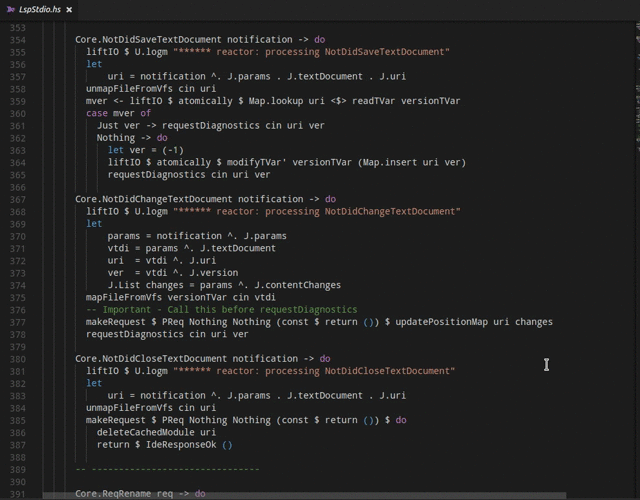This project aims to be the universal interface to a growing number of Haskell tools, providing a full-featured and easy to query backend for editors and IDEs that require Haskell-specific functionality.
We are currently focusing on using the Language Server Protocol as the interface via which we talk to clients.
-
Supports plain GHC projects, cabal projects(sandboxed and non sandboxed) and stack projects
-
Fast due to caching of compile info
-
Uses LSP, so should be easy to integrate with a wide selection of editors
-
Diagnostics via hlint and GHC warnings/errors
-
Code actions and quick fixes via apply-refact
-
Type information and documentation(via hoogle) on hover
-
Jump to definition
-
List all top level definitions
-
Highlight references in document
-
Completion
-
Formatting via brittany
-
Renaming via HaRe
To install HIE
git clone https://github.com/haskell/haskell-ide-engine
cd haskell-ide-engine
stack installAlternatively, given that you have Nix installed:
$ stack install --nix
Make sure HIE is installed (see above) and directory stack put the hie binary in is in your path
(usually ~/.local/bin on linux)
git clone https://github.com/alanz/vscode-hie-server
cd vscode-hie-server
npm install .Open vscode-hie-server/ in Visual Studio Code and press F5 to open a new window with the extension loaded.
As above, make sure HIE is installed. Install and load the neovim plugin
LanguageClient. If you use
vim-plug, then you can do this by e.g.
including the following line in the Plug section of your init.vim:
Plug 'autozimu/LanguageClient-neovim', { 'do': ':UpdateRemotePlugins' }
and issuing a :PlugInstall command within neovim.
Finally, make sure that hie is included as the language server source for haskell:
let g:LanguageClient_serverCommands = {
...
\ 'haskell': ['hie', '--lsp'],
...
\ }
For asynchronous auto-completion, follow the setup instructions on LanguageClient.
HIE supports fetching docs from hoogle on hover. It can use the Hoogle database for your user, or a project specific database.
To generate a global hoogle database for your user from hackage, run
$ hoogle generateTo generate a project specific database for a stack project, run
$ stack hoogle
$ stack buildTo generate a project specific database for a sandboxed cabal project, run
$ cabal install --enable-documentation --haddock-hoogle
$ hoogle generate --database=hiehoogledb.hoo --local=.in the root dir of your cabal project
If you don't have the dependencies built with haddock/documentation enabled, you need to remove the sandbox and build everything again before running the commands given above
$ cabal sandbox delete
$ cabal sandbox initTo generate a project specific database for a non-sandboxed cabal project, run
$ cabal install
$ hoogle generate --local --database=hiehoogledb.hooIf HIE detects a project specific hoogle DB, it will use it over the global db.
- Multiproject support
- Project wide references
- Cross project find definition
- New-build support
- HaRe refactorings
- More code actions
- Cross project/dependency Find Definition
- Case splitting, type insertion etc.
This is not yet another ghc-mod or ide-backend project
Both the ghc-mod and ide-backend maintainers have agreed to contribute code to this new repository and then rebase the old repos on this. The reason we're using a new repo instead of modifying one of the existing ones is so that the existing projects experience no disruption during this migration process. If this was a new set of people starting a new project without support from existing projects, I'd agree with you. But Alan's reached out to existing players already, which is an important distinction.
This project is not started from scratch:
- See why we should supersede previous tools
- Check the list of existing tools and functionality
- See more other tools and IDEs for inspiration
❤️ Haskell tooling dream is near, we need your help! ❤️
- Register in our google group mailing list.
- Join our IRC channel at
#haskell-ide-engineonfreenode. - Fork this repo and hack as much as you can.
- Ask @alanz or @hvr to join the project.
Apart from stack you need cask for the emacs tests. You can install it using
curl -fsSL https://raw.githubusercontent.com/cask/cask/master/go | python
Below you find a short overview of the main architectural layers of haskell-ide-engine.
For more info have a look in the docs folder at the root of this project, especially:
ghc-mod stays an AGPL project,
and is used for its "awesome sauce" in terms of
the BIOS functions that it does so well. This interface is
straightforward to use,
and if a license-constrained user wants to do something else it is also easy to
replace, if there is strong control of the operating environment.
A layer providing a point to integrate tools and existing functions, probably including ghci.
The focus is currently on LSP as the protocol we use to interface with IDEs.
Existing transports are still functional for the time being.
All the documentation is in the docs folder at the root of this project.









